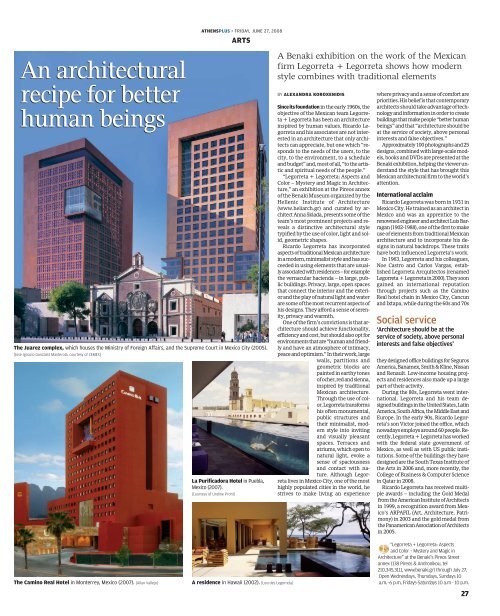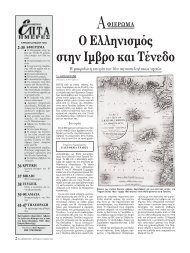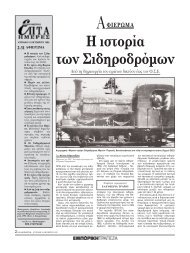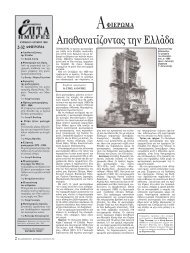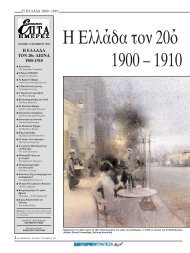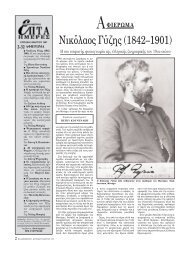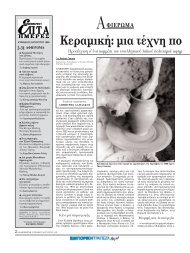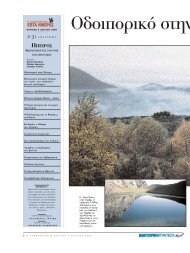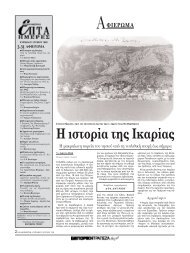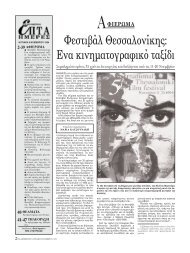27-06-2008
27-06-2008
27-06-2008
You also want an ePaper? Increase the reach of your titles
YUMPU automatically turns print PDFs into web optimized ePapers that Google loves.
An architectural<br />
recipe for better<br />
human beings<br />
ATHENSPLUS • FRIDAY, JUNE <strong>27</strong>, <strong>2008</strong><br />
ARTS<br />
The Juarez complex, which houses the Ministry of Foreign Affairs, and the Supreme Court in Mexico City (2005).<br />
[Jose Ignacio Gonzalez Manterola, courtesy of CEMEX]<br />
La Purificadora Hotel in Puebla,<br />
Mexico (2007).<br />
[Courtesy of Undine Prohl]<br />
The Camino Real Hotel in Monterrey, Mexico (2007). [Allan Vallejo] A residence in Hawaii (2002). [Lourdes Legorreta]<br />
A Benaki exhibition on the work of the Mexican<br />
firm Legorreta + Legorreta shows how modern<br />
style combines with traditional elements<br />
BY ALEXANDRA KOROXENIDIS<br />
Since its foundation in the early 1960s, the<br />
objective of the Mexican team Legorreta<br />
+ Legorreta has been an architecture<br />
inspired by human values. Ricardo Legorreta<br />
and his associates are not interested<br />
in an architecture that only architects<br />
can appreciate, but one which “responds<br />
to the needs of the users, to the<br />
city, to the environment, to a schedule<br />
and budget” and, most of all, “to the artistic<br />
and spiritual needs of the people.”<br />
“Legorreta + Legorreta: Aspects and<br />
Color – Mystery and Magic in Architecture,”<br />
an exhibition at the Pireos annex<br />
of the Benaki Museum organized by the<br />
Hellenic Institute of Architecture<br />
(www.heliarch.gr) and curated by architect<br />
Anna Skiada, presents some of the<br />
team’s most prominent projects and reveals<br />
a distinctive architectural style<br />
typified by the use of color, light and solid,<br />
geometric shapes.<br />
Ricardo Legorreta has incorporated<br />
aspects of traditional Mexican architecture<br />
in a modern, minimalist style and has succeeded<br />
in using elements that are usually<br />
associated with residences – for example<br />
the vernacular hacienda – in large, public<br />
buildings. Privacy, large, open spaces<br />
that connect the interior and the exterior<br />
and the play of natural light and water<br />
are some of the most recurrent aspects of<br />
his designs. They afford a sense of serenity,<br />
privacy and warmth.<br />
One of the firm’s convictions is that architecture<br />
should achieve functionality,<br />
efficiency and cost, but should also opt for<br />
environments that are “human and friendly<br />
and have an atmosphere of intimacy,<br />
peace and optimism.” In their work, large<br />
walls, partitions and<br />
geometric blocks are<br />
painted in earthy tones<br />
of ocher, red and sienna,<br />
inspired by traditional<br />
Mexican architecture.<br />
Through the use of color,<br />
Legorreta transforms<br />
his often monumental,<br />
public structures and<br />
their minimalist, modern<br />
style into inviting<br />
and visually pleasant<br />
spaces. Terraces and<br />
atriums, which open to<br />
natural light, evoke a<br />
sense of spaciousness<br />
and contact with nature.<br />
Although Legorreta<br />
lives in Mexico City, one of the most<br />
highly populated cities in the world, he<br />
strives to make living an experience<br />
where privacy and a sense of comfort are<br />
priorities. His belief is that contemporary<br />
architects should take advantage of technology<br />
and information in order to create<br />
buildings that make people “better human<br />
beings” and that “architecture should be<br />
at the service of society, above personal<br />
interests and false objectives.”<br />
Approximately 100 photographs and 25<br />
designs, combined with large-scale models,<br />
books and DVDs are presented at the<br />
Benaki exhibition, helping the viewer understand<br />
the style that has brought this<br />
Mexican architectural firm to the world’s<br />
attention.<br />
International acclaim<br />
Ricardo Legorreta was born in 1931 in<br />
Mexico City. He trained as an architect in<br />
Mexico and was an apprentice to the<br />
renowned engineer and architect Luis Barragan<br />
(1902-1988), one of the first to make<br />
use of elements from traditional Mexican<br />
architecture and to incorporate his designs<br />
in natural backdrops. These traits<br />
have both influenced Legorreta’s work.<br />
In 1963, Legorreta and his colleagues,<br />
Noe Castro and Carlos Vargas, established<br />
Legorreta Arcquitectos (renamed<br />
Legorreta + Legorreta in 2000). They soon<br />
gained an international reputation<br />
through projects such as the Camino<br />
Real hotel chain in Mexico City, Cancun<br />
and Ixtapa, while during the 60s and 70s<br />
Social service<br />
‘Architecture should be at the<br />
service of society, above personal<br />
interests and false objectives’<br />
they designed office buildings for Seguros<br />
America, Banamex, Smith & Kline, Nissan<br />
and Renault. Low-income housing projects<br />
and residences also made up a large<br />
part of their activity.<br />
During the 80s, Legorreta went international.<br />
Legorreta and his team designed<br />
buildings in the United States, Latin<br />
America, South Africa, the Middle East and<br />
Europe. In the early 90s, Ricardo Legorreta’s<br />
son Victor joined the office, which<br />
nowadays employs around 60 people. Recently,<br />
Legorreta + Legorreta has worked<br />
with the federal state government of<br />
Mexico, as well as with US public institutions.<br />
Some of the buildings they have<br />
designed are the South Texas Institute of<br />
the Arts in 20<strong>06</strong> and, more recently, the<br />
College of Business & Computer Science<br />
in Qatar in <strong>2008</strong>.<br />
Ricardo Legorreta has received multiple<br />
awards – including the Gold Medal<br />
from the American Institute of Architects<br />
in 1999, a recognition award from Mexico’s<br />
ARPAFIL (Art, Architecture, Patrimony)<br />
in 2003 and the gold medal from<br />
the Panamerican Association of Architects<br />
in 2005.<br />
“Legorreta + Legorreta: Aspects<br />
and Color – Mystery and Magic in<br />
Architecture” at the Benaki’s Pireos Street<br />
annex (138 Pireos & Andronikou, tel<br />
210.345.3111, www.benaki.gr) through July <strong>27</strong>.<br />
Open Wednesdays, Thursdays, Sundays 10<br />
a.m.-6 p.m, Fridays-Saturdays 10 a.m - 10 p.m.<br />
<strong>27</strong>


